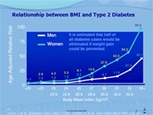
Effects of Diabetes
Effects of Diabetes Complications
Diabetes mellitus can affect many parts of the body and can lead to serious complications such as nerve damage, blood vessel damage, blindness, kidney damage, and lower limb amputations. Diabetes is the sixth leading cause of death listed on U.S. death certificates in 2002. Overall, the risk for death among people with diabetes is about twice that of people without diabetes of similar age.
Diabetes mellitus is on the rise, particularly Type 2 adult-onset diabetes according to the Centers for Disease Control and Prevention (CDC). There are 23.6 million people with diabetes in the United States and 56 million people who are in danger of becoming diabetic, as of November 2008.
What causes the rise?
The alarming increase of diabetes prevalence has occurred because of:
- Aging population
- Weight Gain: Obesity
- Unhealthy diet
- Overweight and obesity
- A sedentary lifestyle
All over the world, traditional lifestyles and dietary patterns that have sustained people over generations are disappearing. Socioeconomic realities mean that families are often forced to move away from rural areas and into urban areas to seek employment. Diabetes is primarily concentrated in urban areas and this characteristic is destined to increase in the future.
Diabetes mellitus refers to a set of several diseases. The most common types of diabetes are Type 1, or insulin-dependent diabetes mellitus, and Type 2, or non-insulin-dependent diabetes mellitus. A third type of diabetes, gestational diabetes mellitus, occurs during 5 percent of pregnancies.
According to the American Diabetes Association, about 5% of all diabetics have the familial, type 1 form of diabetes, caused by dysfunction in the cells that produce insulin. The other 95 percent of cases are Type 2 diabetes, which usually occurs in adulthood and is closely linked to obesity.
In Type 2 diabetes, the body either does not produce enough insulin, or the body’s cells gradually lose sensitivity to insulin, causing a loss of control of blood sugar levels.
All people with diabetes have one thing in common. They have too much sugar, or glucose, in their blood. People with very high or poorly controlled blood glucose levels share many similar symptoms: an unusual thirst, a frequent desire to urinate, blurred vision, and feeling of being tired most of the time for no apparent reason.
People with type 2 diabetes may also experience leg pain that may indicate nerve damage (neuropathy), or poor blood circulation. Many people with type 1 diabetes and some people with type 2 diabetes also find that they lose weight even though they are hungrier than usual and are eating more.
The increase in obesity is tied to the rise in diabetes. As the number of Americans with diabetes increased by millions, so did the number of obese Americans – that is those who are 20 percent or more than their normal weight. The rate of obesity in the United States increased by 74 percent as measured by the CDC.
- 61 million (31 percent) of American adults aged 20 and up are obese.
- 65 percent of U.S. adults are either overweight or obese.
- 80 percent of people who develop type 2 diabetes are obese.
Before people develop Type 2 diabetes, they almost always have pre-diabetes” – blood glucose levels that are higher than normal but not yet high enough to be diagnosed as diabetes – that is between 100 mg/dl and 125 mg/dl. There are 41 million people in the United States, ages 40 to 74, who have pre-diabetes.
1.5 million new cases of diabetes were diagnosed in people aged 20 years or older in 2005, slightly up from the 1.4 million number in 2004. This trend (7 percent annual increase) has been assumed to be static/constant over the next three years. Unfortunately, this is likely a very conservative estimate given the trends that are being observed in the population nationally.
According to the CDC:
- Adults with diabetes have heart disease death rates about 2 to 4 times higher than adults without diabetes
- About 73 percent of adults with diabetes have blood pressure greater than or equal to 130/80 millimeters of mercury (mmHg) or use prescription medications for hypertension.
- Diabetes is the leading cause of new cases of blindness among adults aged 20-74 years.
- Diabetes is the leading cause of kidney failure, accounting for 44 percent of new cases in 2005.
- About 60 to 70 percent of people with diabetes have mild to severe forms of nervous system damage (neuropathy). The results of such damage include impaired sensation or pain in the feet or the hands, slowed digestion of food in the stomach, carpal tunnel syndrome, and other nerve problems.
- More than 60 percent of non-traumatic lower-limb amputations occur in people with diabetes.
- Periodontal (gum) disease is more common in people with diabetes. Almost one-third of people with diabetes have severe periodontal disease with detachment of the gum tissue from the teeth measuring 5 millimeters or more.
- Poorly controlled diabetes before conception and during the first trimester of pregnancy can cause major birth defects in 5 to 10 percent of pregnancies and spontaneous abortions in 15 to 20 percent of pregnancies.
-
People with diabetes are more susceptible to many other illnesses and once they acquire these illnesses, often have worse prognoses. For example, they are more likely to die with pneumonia or influenza than people who do not have diabetes.
Living with diabetes requires a change in lifestyle to ensure that blood glucose levels are kept under control. The eating and exercise plan is the same as those of anyone who wants to be healthy. Of course, this is augmented by any recommended medications from your doctor, oral diabetes medications or insulin injections.
The most comprehensive care includes the following:
- Nurse educators who can counsel you on self-care, like how to use a glucose meter
- Dietitian who can help you alter your diet/meal plan
- Ophthalmologist who can be pro-active about treat any detected diabetic related eye disease such as retinopathy
- Neurologist to help you deal with nerve damage
- Podiatrist experienced in treating diabetic foot problems (including calluses, sores, ulcers or helping you prevent future foot injuries)
- Mental Health professional to help you cope with depression, anxiety or other mental health problems
- Exercise specialist to help you develop and stick with an exercise plan
- Pharmacist to provide information about diabetes drugs and self-care products (such as meters)
- Dentist to help ensure early identification of gum disease and other pertinent issues
- Dermatologist to regularly check your skin for any indications of cuts, infections, poor circulation, etc.




